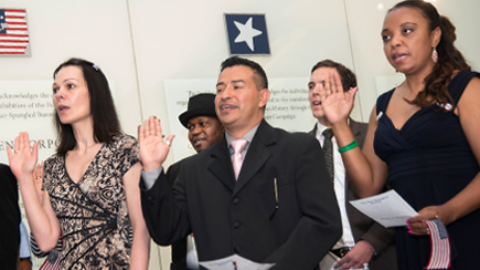Research and Analysis

Economic Progress via Legalization: Lessons from the Last Legalization Program
The data analyzed in this report indicates that unauthorized immigrants who gained legal status in the 1980s through the legalization provisions of the Immigration Reform and Control Act (IRCA) experienced clear improvement in their socioeconomic situation. Between 1990 and 2006, the educational attainment of IRCA immigrants increased substantially, their poverty rates fell dramatically, and their home ownership rates improved tremendously. Moreover, their real wages rose, many of them moved into managerial positions, and the vast majority did not depend upon public assistance. The findings presented in this report support the notion that legalization of unauthorized immigrants can play a role in promoting economic growth and lessening socioeconomic disparities. Reforming our immigration system is not an obstacle to getting our economy back on track—it is part of the solution. Originally Published Nov. 5, 2009 Read More

Back to the Future: The Impact of Legalization Then and Now
While there are many facets to an intelligent immigration reform package, one thing is clear: legalization for undocumented immigrants helps all of us. Most economists recognize that legalization has worked in the past. After a significant percentage of the undocumented population legalized under the Immigration Reform and Control Act of 1986 (IRCA), information on IRCA applicants was used to assess the legislation’s impact. My own research has shown that IRCA provided immediate direct benefits by successfully turning formerly clandestine workers into higher-paid employees. Other researchers have shown that IRCA provided unexpected indirect benefits to the communities where legalized immigrants resided. After legalization, fewer of these immigrants sent money back to their home countries, and those who sent back money sent back less. More of their earnings were spent in their communities in the United States. Research also showed that the legalized population became participating community members—nearly two out of five people who legalized under IRCA were U.S. citizens by 2001. What we learned from IRCA gives us a bird’s eye view into what we can expect to happen with a new legalization program. By examining three areas of concern: work, family, and community, we can see what economic and social benefits would be derived from a legalization program in 2013. By Sherrie A. Kossoudji, Ph.D. Read More

A Decade of Rising Immigration Enforcement
With roughly 11 million unauthorized immigrants living in the United States, some question whether the nation’s immigration laws are being seriously enforced. In truth, due to legal and policy changes in recent years, the immigration laws are enforced more strictly now than ever before. The Department of Homeland Security (DHS) has reported record numbers of removals during the Obama administration, especially of noncitizens with criminal convictions. Meanwhile, fewer noncitizens are trying to enter the country illegally, and those caught by the Border Patrol are now regularly charged with federal crimes. Together, these trends reflect a sweeping and punitive transformation in U.S. immigration enforcement. Click Here for PDF Version “Removals” & “Returns” When noncitizens who violate the immigration laws are forced to leave the United States, their departure is classified as a “removal” or a “return.” (See the glossary for definitions of these terms.) DHS reported 391,953 “removals” during the 2011 fiscal year, slightly below the record set in 2009. Meanwhile, DHS reported 323,542 “returns” in 2011, the lowest number since 1970 {Figure 1}. Figure 1: DHS “removals” & “returns” FY 2002-2011 Read More

Falling Through the Cracks
The Impact of Immigration Enforcement on Children Caught Up in the Child Welfare System One of the many consequences of an aggressive immigration enforcement system is the separation of children, often U.S. citizens, from their unauthorized immigrant parents. Take the case of Felipe Montes, a father who has spent the past two years fighting to reunite with his three young children, who were placed in foster care in North Carolina following Montes’ deportation to Mexico in late 2010. Such cases only scratch at the surface of a growing problem. Our immigration policies often fail to address the needs of millions of children whom they directly impact. According to the Pew Hispanic Center, approximately 5.5 million children in the United States, including 4.5 million U.S.-born citizens, live in mixed-legal status families with at least one parent who is an unauthorized immigrant. These children are at risk of being separated from a parent at any time. Parents facing removal must frequently make the decision whether to take their children with them or leave their children in the U.S. in the care of another parent, relative, or friend. In many cases, a parent may determine that it is in their child’s best interest to remain in the U.S. However, in some cases, a parent’s ability to make such decisions is compromised when their child enters the child welfare system, which can prompt a series of events leading to the termination of parental rights. The lack of consistent protocols across the different public systems that encounter separated families further exacerbates the problem. Read More

The 287(g) Program: An Overview
Through the 287(g) program, state and local police officers collaborate with the federal government to enforce federal immigration laws. In the past, the 287(g) program has been costly for localities, has not focused on serious criminals, and has Read More

Who and Where the DREAMers Are, Revised Estimates
There are roughly 1.8 million immigrants in the United States who might be, or might become, eligible for the Obama Administration’s “deferred action” initiative for unauthorized youth brought to this country as children. Read More

Border Patrol Agents as Interpreters Along the Northern Border: Unwise Policy, Illegal Practice
Advocates along the Northern Border report a recent, sharp increase in the use of U.S. Border Patrol (USBP) agents to provide interpretation services to state and local law enforcement officers and emergency responders. This most often occurs when an officer or responder encounters an individual who does not speak English and proactively reaches out to USBP for assistance. But it has also occurred when USBP agents respond to an incident report in lieu of, or in addition to, local law enforcement officers. In other cases, USBP agents have reportedly begun responding to 911 emergency assistance calls, especially if the caller is known or perceived not to speak English. Much of this activity appears to have been precipitated by the fact that the U.S.-Canada border has undergone a dramatic transformation, including an influx of newly assigned USBP agents.Immigrants, their advocates, and community members are reporting—and official statistics confirm—that there are simply too many USBP agents on the ground, apparently with too much time on their hands, who lack adherence to stated priorities.This special report by Lisa Graybill for the Immigration Policy Center lays out the problems with border patrol agents serving as translators and make recommendations intended to promote Title VI compliance, maintain the integrity of the USBP mission on the Northern Border, and protect the rights of immigrants and their families who call the Northern Border home. Listen to the teleconference. Read More

Citizenship Day 2012: Realizing the Potential of the Immigrant Vote
For many aspiring immigrants, achieving citizenship means full participation in civic life—and that means the right to vote. Every year, thousands of immigrants become naturalized U.S. citizens and exercise their new right. In the 2010 national elections, naturalized citizens comprised 6.4% of all voters. The voter registration rate among immigrants as a whole has risen since 2000. Just as importantly, a growing number of U.S.-born children of immigrants are now coming of age and becoming voters. However, the full potential of the immigrant vote has not been reached. There are more than eight million legal immigrants in the United States who are eligible to naturalize but have not yet done so. The latent electoral power of these voters-in-waiting is enormous. In many parts of the country their votes could potentially swing elections. As described in a series of Immigration Impact blog posts by Rob Paral, there are numerous counties across the country where the number of Legal Permanent Residents (LPRs) who have arrived since 1985 exceeds the margin of victory in the Obama-McCain election. Moreover, the voter rolls of many counties would grow dramatically if LPRs who are eligible to naturalize actually did so and registered to vote. Although this could not happen in time for the 2012 election cycle, it could make a difference in future elections. In many U.S. counties, the number of Legal Permanent Residents (LPRs) who have arrived since 1985 exceeds the Obama-McCain margin of victory. Read More

Deferred Action for Childhood Arrivals: A Q&A Guide
Here's what you need to know about the “Deferred Action for Childhood Arrivals” (DACA) initiative, including eligibility requirements and important information on process and timing. Read More

Using the Systematic Alien Verification for Entitlements (SAVE) Program for Voter Eligibility Verification
The evidence of non-citizens voting is sparse and appears subject to much exaggeration. Despite this, many states are asking the federal government for access to immigration data in order to determine whether non-citizens are on the voter registration rolls. For instance, in July 2012, the Director of U.S. Citizenship and Immigration Services (USCIS)—a division of the Department of Homeland Security (DHS)—advised the Florida Secretary of State that states, under limited circumstances, may use the Systematic Alien Verification for Entitlements (SAVE) program for verification of the citizenship status of registered voters. This issue, however, goes beyond Florida. Other states have expressed an interest in using SAVE in a similar fashion. This new development has heightened misconceptions about the SAVE program and its purpose. The Immigration Policy Center’s previously issued fact sheet about the SAVE program focuses on whether SAVE can actually verify whether an individual is in the country lawfully or not. This fact sheet focuses on whether the SAVE program can be used to accurately verify voter eligibility. It explains why SAVE is not a database of all non-citizens, why using SAVE to verify the status of individuals who have registered to vote is a misuse of the program, and how using SAVE for this purpose could lead to denying U.S. citizens the right to vote. What is the SAVE program? Read More
Make a contribution
Make a direct impact on the lives of immigrants.
